Medals and Ribbons
.
The Army awarded eligible WAC members with medals and citations
acknowledging performance of duty during WWII.
.
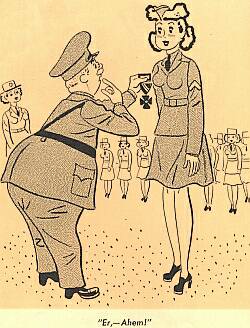 |
For Example:
.
WAC Director Oveta Culp Hobby received the Distinguished
Service Medal as the first woman to be so honored, in 1945.
.
3 WAC members received the Air Medal.
10 WAC members received the Soldier's Medal
for heroic actions under non-combat circumstances.
.
16 WAC members received the Purple Heart,
for being injured during enemy action (most of these injuries were caused
by exploding V-1 bombs while serving in or around London).
.
62 WAC members received the Legion of Merit,
awarded for exceptionally meritorious conduct in the performance of duty.
.
565 WAC members received the Bronze Star
for meritorious service overseas. |
At least 657 WAC members received performance-based medals and citations
at the end of the war, but more medals were awarded through the years as
paperwork was processed during the postwar era.
.
.
Below is a list of decorations that WAC personnel could receive
for their service generally and for service in campaigns during WWII.
.
Women's Army Corps
Service Medal

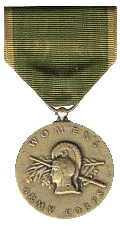
|
.. |
The WAC Service Medal was authorized
on 29 July 1943 and awarded for military service in:
- the Women's Army Auxiliary Corps (WAAC)
between 10 July 1942 and 31 August 1943.
- the Women's Army Corps (WAC) between 1 September
1943 and 2 September 1945.
The ribbon colors are the branch colors of the
Women’s Army Corps. |
| . |
|
|
WW II Victory Medal

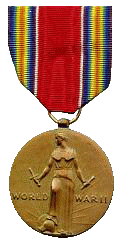
|
|
Awarded to all military personnel
for service between 7 December 1941 and 31 December 1946. The World War
II Victory Medal was established by an Act of Congress on 6 July 1945 (Public
Law 135, 79th Congress).
The specified ending date on December 31, 1946
was the date of the official termination of hostilities as proclaimed by
President Truman.
The Victory Medal was first issued as a ribbon,
and was referred to simply as the "Victory Ribbon".
By 1946, a full medal had been established which
was referred to as the World War II Victory Medal. |
| . |
|
|
American Campaign Medal

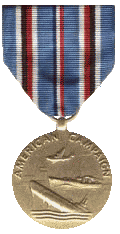
|
|
Awarded for service within the American
Theater from 7 December 1941 past the end of World War II. The American
Campaign Medal was established per Executive Order 9265, dated 6 November
1942, by President Franklin D. Roosevelt. The American Campaig Medal was
first issued as ribbon only.
The ribbon design was approved by the Secretary
of War on 24 November 1942. The blue color represents America.
The blue, white and red stripes in the center
(taken from the American Defense Service Medal ribbon) refers to the continuance
of American defense after Pearl Harbor. The white and black stripes refer
to the German flag colors (the enemy at the Atlantic Coast) while red and
white stripes are for the Japanese colors and refer to that part of the
conflict on the Pacific Coast.
The American Theater included North America,
the Caribbean and certain Atlantic and Pacific islands and South America.
The service had to last at least a period of 30 consecutive days or 60
nonconsecutive days.
On 17 December 1947, the first medal was presented
to General of the Army George C. Marshall. |
| . |
|
|
European-African-Middle
Eastern Campaign Medal
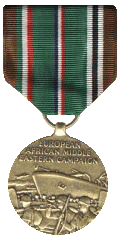
|
|
Awarded for service within the European-African-Middle
Eastern Theater from 7 December 1941 past the end of World War II.
The EAME Campaign Medal was established per Executive
Order 9265 in November 1942 by President Franklin D. Roosevelt. The medal
was first issued as ribbon only.
In December 1942, the ribbon design was approved
by the Secretary of War. The brown represents the sands of Africa and the
green represents the green fields of Europe. The blue, white, and red stripes
in the center are taken from the American Defense Service Medal ribbon
and refer to the continuance of American Defense after Pearl Harbor. Green,
white and red are the Italian colors and the white and black colors represent
Germany.
The European-African-Middle Eastern (EAME) Theater
included Europe, the western Soviet Union, Greenland, Iceland, Africa,
and southwest Asia. The service had to last at least a period of 30 consecutive
days or 60 nonconsecutive days. On 24 July 1947, General Eisenhower was
presented the first medal. |
| . |
|
|
Asiatic-Pacific Campaign
Medal

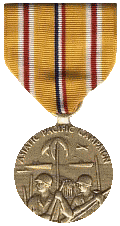
|
|
Alwarded for service within the Asiatic-Pacific
Theater from 7 December 1941 past the end of World War II. The Asiatic-Pacific
Campaig Medal was established per Executive Order 9265 in November 1942
by President Franklin D. Roosevelt.
The ribbon design was approved by the Secretary
of War on 24 November 1942. The white and red stripes on each side
represent the Japanese colors. The blue, white and red stripes in the center
are adopted from the American Defense Service Medal ribbon and refer to
the continuance of American Defense after Pearl Harbor. The medal was first
issued as ribbon only.
The Asiatic-Pacific Theater included Hawaii and
other Pacific Ocean islands, Alaska, Philippines, Australia, New Zealand,
Indonesia, New Guinea and southeast and south Asia as well as the eastern
Soviet Union. The service had to last at least a period of 30 consecutive
days or 60 nonconsecutive days. On 17 December 1947, the first medal was
presented to General of the Army Douglas MacArthur. |
| . |
|
|
Army of Occupation Medal

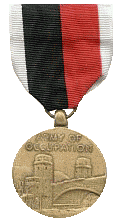
|
|
Awarded for 30 days consecutive service
or more while performing duty in Germany, Austria, Italy, Japan and Korea
at the close of World War II and postwar periods. Exact dates should be
referenced using official Army regulations.
The Army Occupation Medal was established by
War Department Circular 102 in April 1946.
The black color on the ribbon represented Germany,
the color red Japan. A Bronze clasp with the word "GERMANY" or "JAPAN"
ass worn on the suspension ribbon to indicate service in Europe or the
Far East.
The first medal was presented to General Eisenhower
on 2 April 1947. |
.
. |
